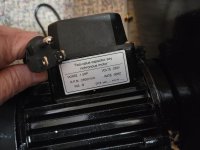jrjr2u
Member
- Location
- Central NY
- Occupation
- retired
I was given a dust collector that presents as new. The motor plate states 220 volt and 50hz. From what I gather the 50hz is a non issue as their support said it is fine on 60hz. The next issue is that this has a 120v plug on the cord. They stated that after changing the plug to a 220v plug it will work as intended here in the states. Inspected the wiring and found that the ground wire that is fastened to the motor frame also passes through the 3 pole switch and is switched along with the power leads. I find this very strange and wouldn't think a ground should be switched.
Is there some anomaly in China that requires a switched ground? In China or other countries is there actually 220v supplied on one wire and completes with a neutral? I have no experience with Asian or European standards. I was going to install the plug and go for it but thought it would be worth the conversation first. Thanks for any info.
Is there some anomaly in China that requires a switched ground? In China or other countries is there actually 220v supplied on one wire and completes with a neutral? I have no experience with Asian or European standards. I was going to install the plug and go for it but thought it would be worth the conversation first. Thanks for any info.



